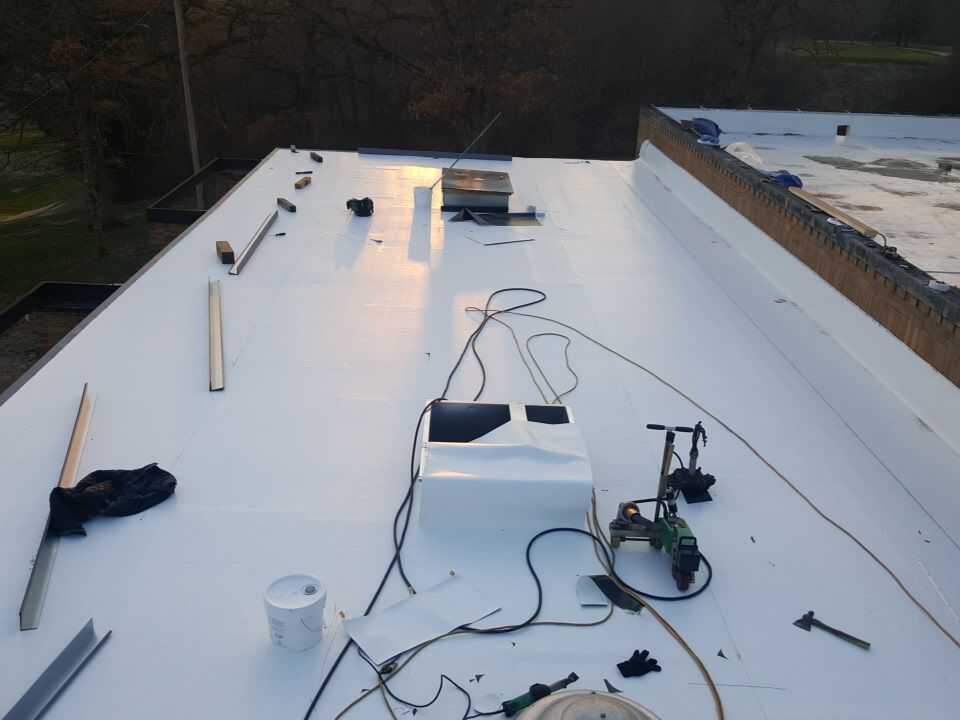You’re building a new property for your business. You’ve got most of the specifics laid out. But you’re still trying to decide on the type of roofing you should use.
There are several options available, all of which offer their own sets of benefits and drawbacks. To help you decide which is best for your business property, we’re going to discuss them in detail below. So, here are the six most common types of commercial roofing in Springfield, IL, without further ado.
1. Metal Roofing
We’ll begin this list with metal roofing, a commercial roofing material available in several different types. There’s zinc roofing, copper roofing, corrugated galvanized steel roofing, tin roofing, and more, each of which carries its own functional and aesthetic attributes.
But regardless of the type you choose, you can expect it to last well over half a decade whilst withstanding everything from rain to sunlight to direct physical trauma. A low-maintenance material, it generally only needs to be cleaned on occasion.
Metal roofing is ideal for sloped roofs, not only because it’s not built for flat roofing purposes but also because it’s aesthetically pleasing. You wouldn’t want to hide it when it could help enhance your property’s look after all.
2. PVC Roofing
If your property has a flat roof, you should consider installing PVC roofing. PVC roofing is beneficial for flat roofs in that it completely rejects the inward flow of water. This is due to its durability (it’s highly resistant to tears) as well as its tight, heat-welded seams.
Another benefit of PVC fencing is that it’s white. As such, instead of absorbing heat, it reflects it, ensuring that it’s not entering the building below. This makes it great for energy efficiency purposes.
Wondering about how the weather impacts PVC roofing? By and large, it doesn’t. PVC roofing expands and contracts, preventing it from becoming cracked and brittle.
In total, you can expect a PVC roof to last around 30 years. That’s quite a long time compared to other flat roof materials (like modified bitumen or built-up roofing).
3. Spray Foam Roofing
Another flat roofing material for you to utilize is spray foam roofing. Spray foam roofing is literally sprayed onto the roof. It’s a liquid substance which then dries and becomes a solid.
Made out of polyurethane, this type of roofing is durable, low-maintenance, and built to withstand large temperature fluctuations. This makes it great for cold weather areas like the Midwest.
Spray foam roofing rarely punctures. As such, it’s almost impossible for water to get through. In other words, it does its job exceedingly well.
All in all, spray foam roofing can last up to 50 years, and, in some cases, even longer. It offers tremendous bang for its buck and is one of the best options for flat roofs.
4. Built-up Roofing
Built-up roofing is the traditional flat roofing material. It consists of several layers of tar and gravel. These layers are built up on top of one another, protecting water, heat, cold, and sound.
The issue with built-up roofing is that it doesn’t last long. In most cases, it’s fully deteriorated within 20 years. This is because, if it springs a leak, that leak will be almost impossible to repair, and the entire roof will need to be replaced instead.
That said, it’s fairly cheap and gets the job done. So, if you’re not looking to spend a lot of money on the install, built-up roofing is a viable option.
5. Thermoset EPDM Roofing
This next roofing material is flat. It’s called thermoset EPDM (Ethylene Propylene Diene Terpolymer), and it comes in large sheets. It’s rolled onto the roof and then connected to other sheets via a variety of processes.
EPDM is a rubber-like material. As such, it offers a good amount of elasticity. Note, though, that it can also puncture fairly easily, giving it durability issues.
Nevertheless, when it’s in prime condition, it does a terrific job of protecting a roof against water, sunlight, heat, cold, and all other types of elements. It even thrives through large temperature fluctuations.
In most cases, it lasts between 20 and 35 years. This is about average for flat roofing materials.
6. Green Roofing
One of the unique forms of roofing is green roofing. Green roofing is essentially a roof consisting of plants. These plants sit upon a waterproof membrane and are used to manage the accumulation of rainfall.
Green roofing systems are set up with intricate drainage and irrigation systems. These systems not only facilitate the feeding of the plants on the roof, but they also assist in evacuating standing water.
These roofs are a good option for those who seek environmental sustainability. In addition to producing good air quality, they also create a welcoming environment for various animals and insects. Plus, they’re nice to look at.
The big issue with green roofing, of course, is that it takes a lot to maintain. A green roof will require you to plant vegetation, trim vegetation, add soil, and more at different points. If you’re busy running a business, these might not be tasks you have the time for.
Need Help Installing Commercial Roofing in Springfield, IL?
Now that you know of some different commercial roofs, you might be looking for a company to facilitate commercial roofing in Springfield, IL. If so, you needn’t look any further. Williams Roofing & Construction has you covered.
We’re well-versed in the installation of all commercial roof types. Regardless of your needs and preferences, we can help.
Contact us today to get the ball rolling!

